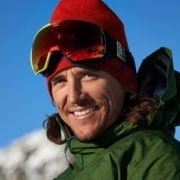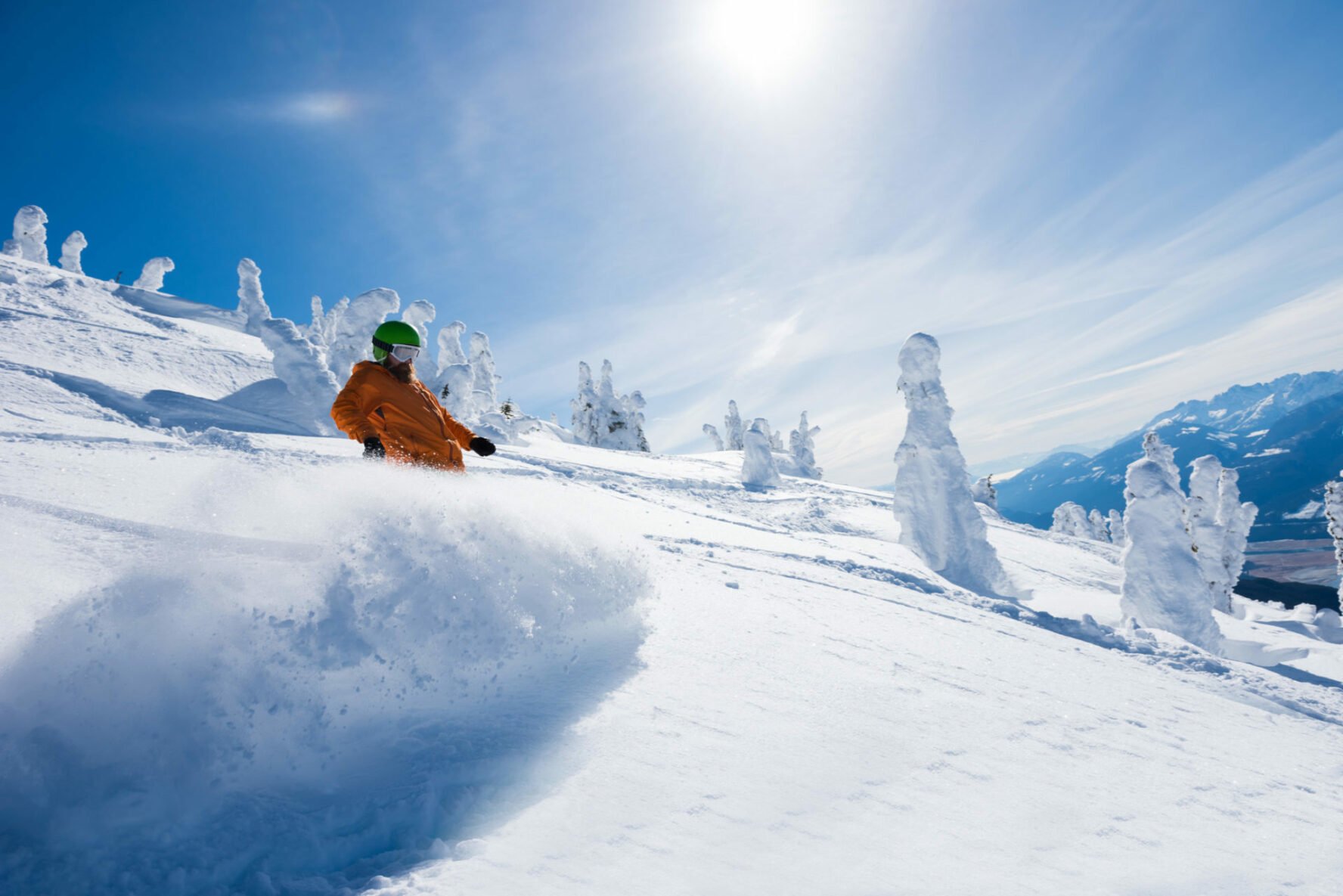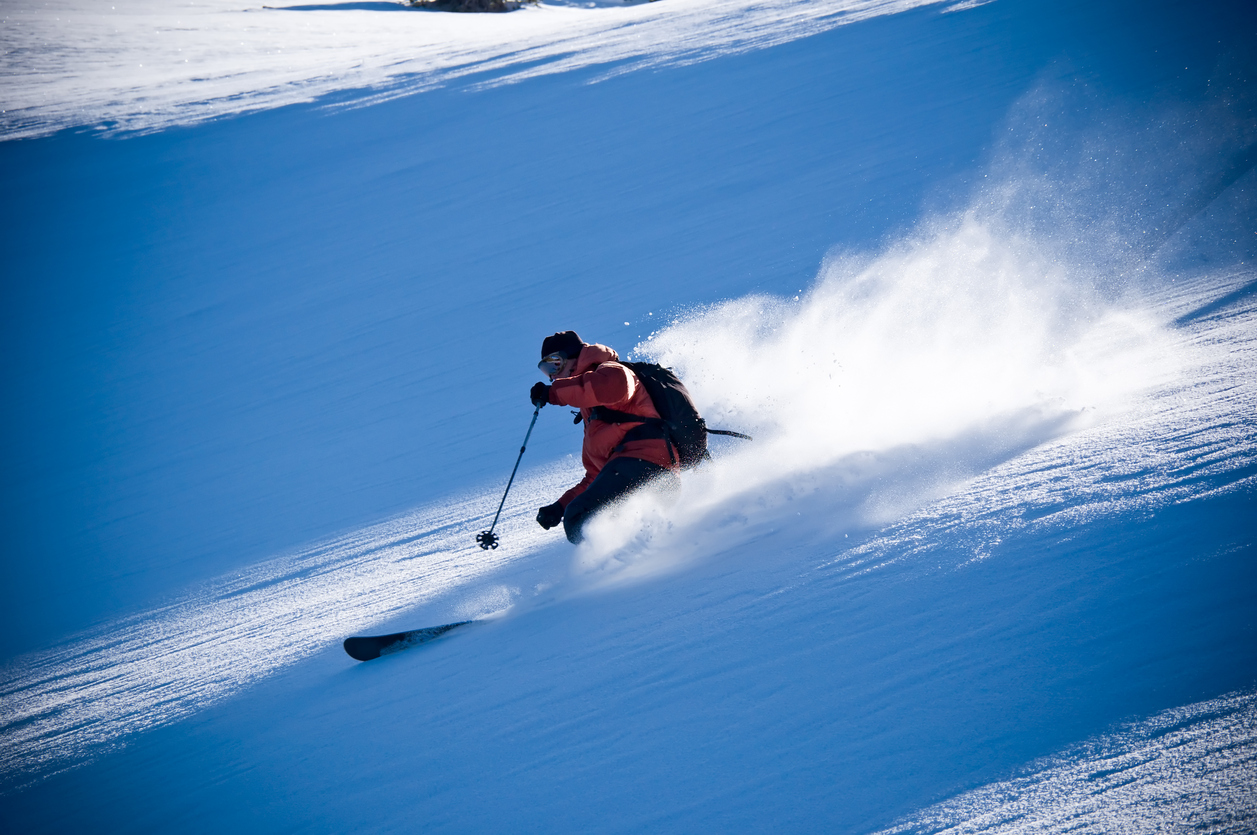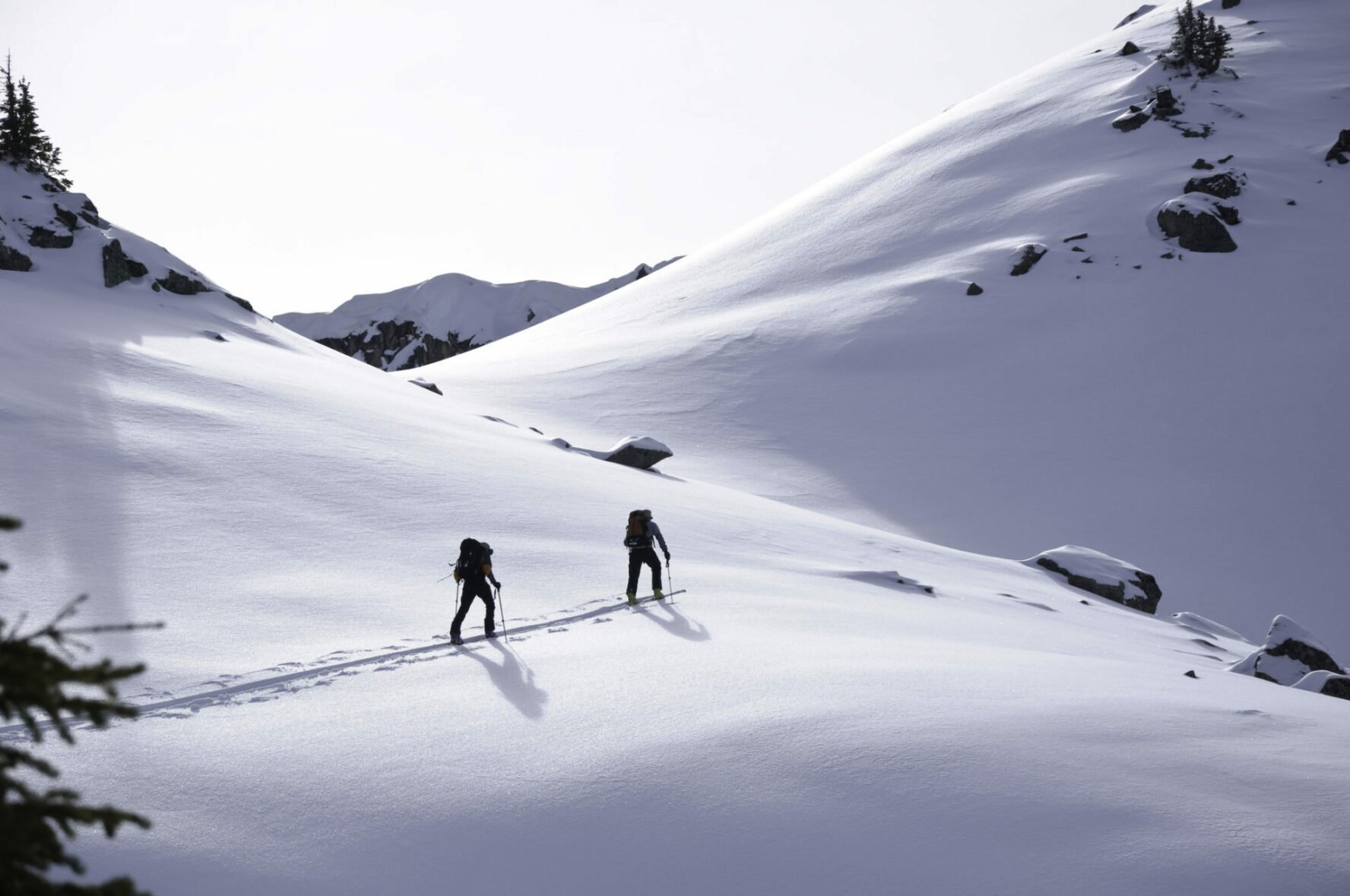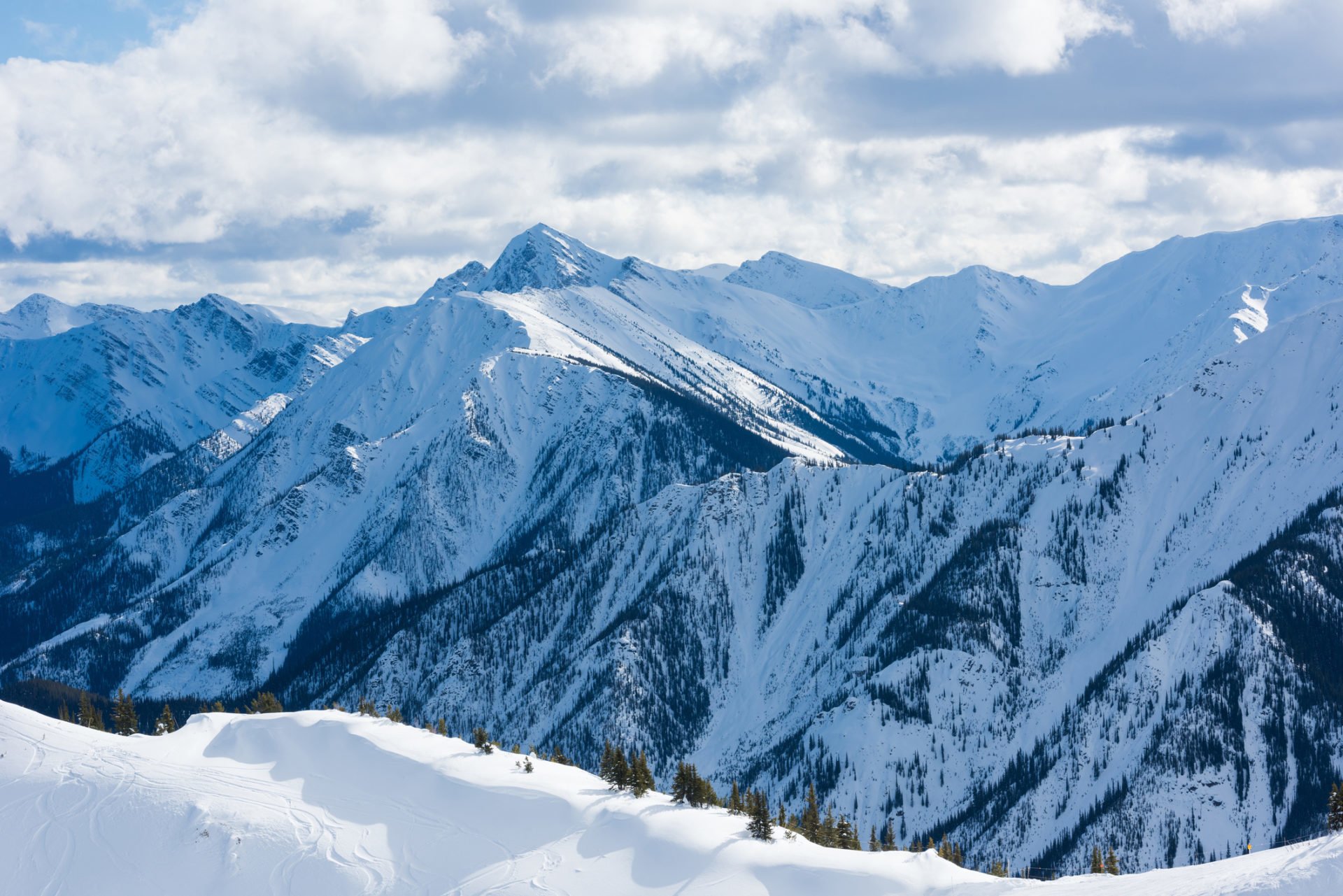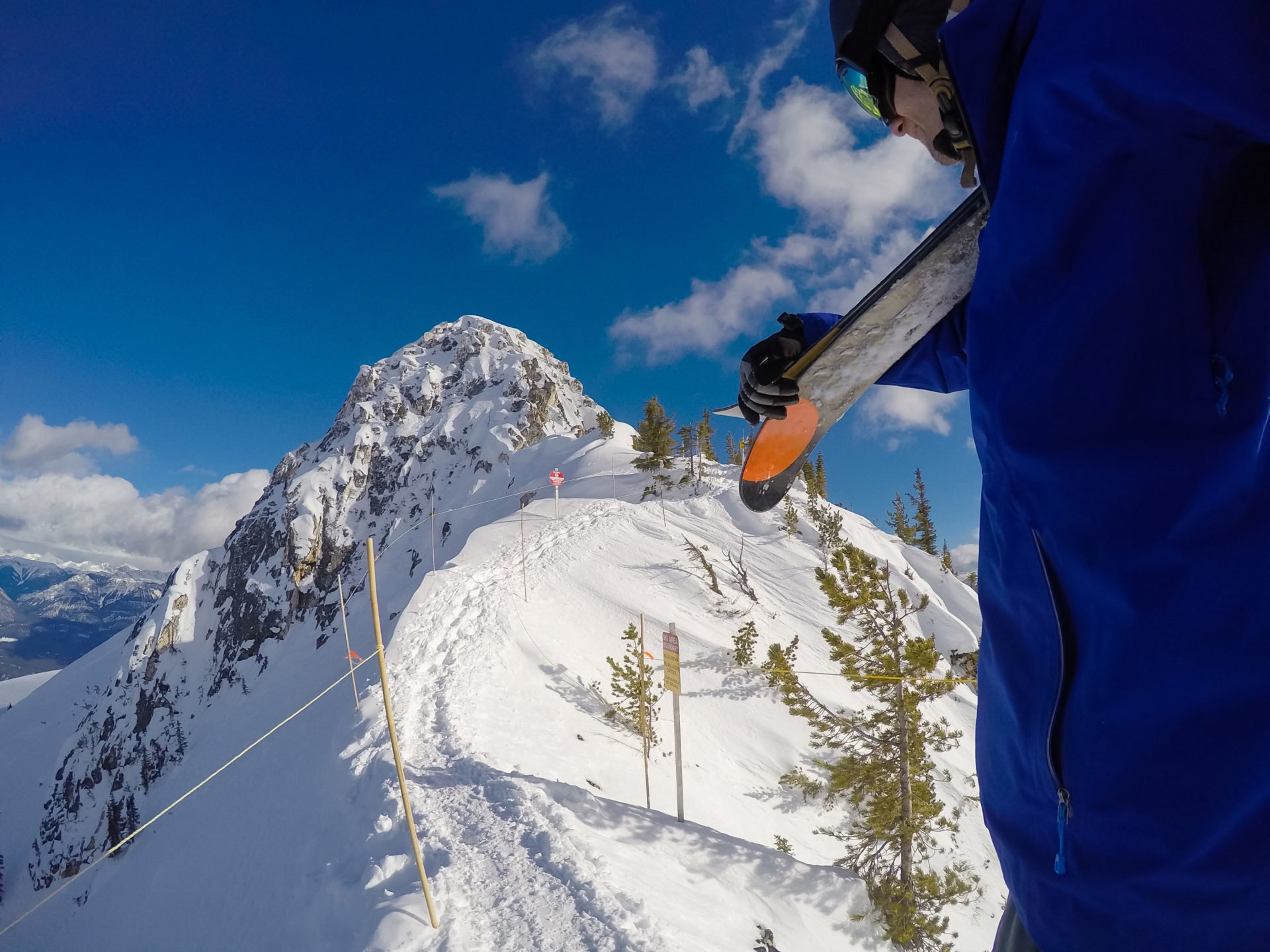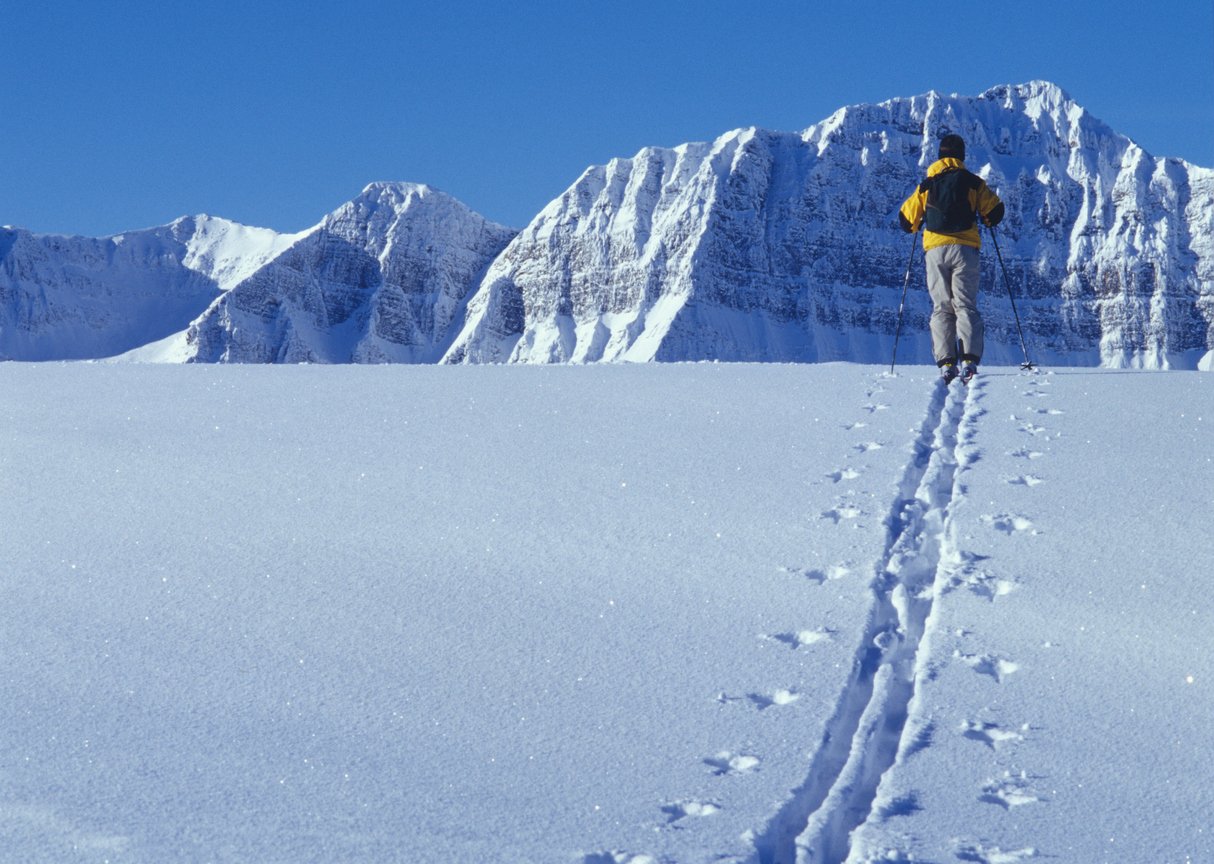Canada is my favorite destination for backcountry skiing in the world. As a pro skier, I’ve skied all over the globe in search of the best powder and nothing beats the quality of snow in Canada, especially in British Columbia and Alberta. I have skied all around here since the ‘90s, and there are still areas that I’ve not even visited, let alone laid my eyes on. And, that’s not to say Eastern Canada doesn’t have its gems. Take it from me, there’s quality powder from coast to coast. Here are the best places to backcountry ski in Canada this winter.

Discover world-class backcountry skiing at the neighbor to the north
Western Canada — British Columbia, in particular — is the birthplace of pillow and heli-skiing. British Columbia offers quality powder you’d expect to find in Alaska or Japan but with far easier access. For people looking to go deeper into the backcountry, I always recommend checking out Canada’s fantastic network of hut-based skiing opportunities. The lodging options are world-class, especially in BC. If you need a day of rest, you’ll also find lodging featuring comfort and style near these skiing destinations. Many properties offer guided experiences that are unparalleled.
Without further ado, I rounded up the destinations as my top picks for the best spots to backcountry ski in Canada. You’ll see why you’ll want to check out Blackcomb, discover the Chic Chocs, and learn about powder quality, terrain and accommodations everywhere in between.
1. Rogers Pass
If you’re trying to decide where to shred this winter, consider Rogers Pass — one of the most iconic backcountry skiing locations in Canada. Expect an unparalleled amount of snow, which combined with a longer than usual season, makes Rogers Pass area a no-brainer. It truly has it all: tree runs to rival the skiing in Tuckerman Ravine, couloirs, glaciers, you name it. And unlike other destinations in Canada, you’ll find beginner terrain as well as complex, full-mountain terrain. Beginner options are also found in Chamonix, such as skiing the La Vallée Blanche route, though this area in France has a lot more crowds than Rogers Pass.
It’s best if you are able to hike 3300 feet (1000m) to really benefit from the area. Revelstoke is considered by many to have the best backcountry terrain in North America. The powder! There are intense storms, but with less water content. Yup, perfect powder. As always, because of the enormity of the Pass, and its massive potential, ski smart and safe.
Head to Connaught Creek for the best places to ski in Rogers Pass
The best valley to initially discover in Rogers Pass is the Connaught Creek. The amount of skiing up this valley is mind boggling. Heading to Balu Pass will allow you to wander under multiple incredible couloirs and impressive mountainscapes. Heading up towards 8812 Bowl or Video Peak will ignite the backcountry dreamer in you. Plus, my favorite spots will give you weeks worth of skiing.
…And my ultimate Roger Pass recommendation
The Illecillewaet Glacier is one of my favorite spots with the imposing Sir Donald mountain towers above the skin track. The blue ice of the glacier reminds me of times past. The Illecillewaet Glacier is the oldest studied glacier in North America and is shrinking daily. Heading up to Pearly Rock gives you priceless views and many skiing possibilities. You’ll get up close and personal with an epic piece of Mother Nature.
What to know before you go
Since Rogers Pass is located in the Glacier National Park, you will need a national park pass during winter. Areas in the pass can be open or closed depending on the current conditions. You will need a permit to ski in many of the areas. Regular visitors can apply for an annual permit, or get a daily winter permit at the Rogers Pass Information Center. The permit system in place allows rangers to control where skiers are located and the safety of the highway when performing avalanche control.
Rogers Pass has everything I’ve ever wanted as a backcountry skier — big vertical, deep powder and endless opportunity.
Rogers Pass - Good to Know
Advanced and expert skiers love it here
Couloirs, bowls, tree skiing, alpine — you name it
Consider elevation gains anywhere from 5900’/1800m (7 steps of Paradise) to 3770’/1160m (Perley Rock)
Great off-the-road adventures, as well as long valley slogs. Most approaches are longer than usual, but you’ll be rewarded
Excellent, dry powder. Extreme weather conditions can close the pass, so plan accordingly
Rogers Pass: Uptracks, Bootpacks & Bushwacks by Douglas Sproul is a must
Late January through mid-March
Getting there
Depending on if you fly to Calgary or Kelowna, you can either stay in Revelstoke or Golden. Both areas are around 43 miles (70km) from the Pass.
2. Revelstoke
Get ready for the biggest vertical drop in North America at 5,620 feet (1,713m). Not nothing. The quality of the powder, the relief of the mountains, and the endless skiing are why I chose to make Revelstoke home 20 years ago. Revelstoke backcountry skiing is incredible and access off the Mountain Resort (RMR) leads to a variety of unforgettable terrain. I believe most advanced skiers will be stoked on the fantastic glade skiing, steep couloirs and summits. Skiing the south facing trees is another must, and I highly recommend it. Revelstoke is home to many backcountry guides and outfitters, so you can find plenty of options and local support for attaining new objectives.
Big terrain. Big everything in Revelstoke
Revelstoke features one of the largest areas for off-piste skiing with 3,121 acres to shred. Like Whistler and Blackcomb, there’s great benefit in using RMR lifts to access some stunning backcountry spots. Be aware, all of the backcountry skiing here is for the intermediate and advanced skier. I recommend skiing with a guide or a super experienced partner who knows the terrain.
Revelstoke drops you in the epicenter of backcountry skiing
You’ll find plenty of hotels in and around Revelstoke Mountain Resort. Any one of these accommodations will get you plenty close to getting your day started in the backcountry.
Skiing the south facing trees is fantastic and highly recommended. Revelstoke is home to many backcountry guides and outfits, so there’s plenty of options for getting out and attaining new objectives.
Revelstoke - Good to Know
Mostly terrain for advanced and expert skiers
Glade skiing, big verticals, alpine terrain, bowls, big, bold chute skiing
2225 m (7300 ft). Consider elevation gains anywhere from 5250’/1600m (Mt. Macpherson – Summit via SE Face) to 565’/200m (Door Chutes via RMR Stoke Chair)
Good slackcountry access via RMR lifts, other spots require some serious effort
The snow quality is excellent
The weather here is ideal for powder, because it’s so far inland
Dec to mid-April
Getting there
Revelstoke’s nearest airport is in Kelowna, BC (YLW), with about a 2.5-hour drive between the two. Once you’ve arrived, you can rent a car at the airport. Alternatively, you can take a bus or shuttle to the resort. If you’re not able to score a direct flight to Kelowna, consider Vancouver (YVR, 6-hour drive) and Calgary (4.5-hour drive) for transfer points.
3. Whistler Blackcomb
Don’t confuse Blackcomb with Whistler! Yes, they’re side by side and practically related, but they’re still two very different mountains. This is where I cut my teeth getting into backcountry skiing, and I learned a lot from these mountains.
Whistler’s backcountry options for beginner and intermediate skiers
Skiers will find a little bit of everything at Whistler. While this ski area is known for its resort, you’ll find ample backcountry opportunities. With plenty of tree skiing and alpine meadows, you’ll find access for all skill levels, including fantastic beginner terrain just beyond the resort boundaries. It’s also worth mentioning that Whistler has stunning views on clear weather days, which makes for awesome bowl skiing. If there’s any precipitation, the area can feel closed in and small. Regardless, it’s an awesome place for beginner to intermediate skiers, with plenty of amenities in the area for downtime.
My favorite Whistler backcountry routes
Flute Backside is where you’ll find laid-back powder skiing. On the east flank of Oboe, you’ll come across The Apostle. Continue on to take in the classic lines at Cowboy Ridge. Here, the runs get a lot less traffic than other popular spots, and you’ll still be back in time for that after-ski beer. If you’re looking for something a little more complex, venture farther east to Fissile Peak and beyond where you’ll be rewarded with challenging, glaciated alpine terrain.
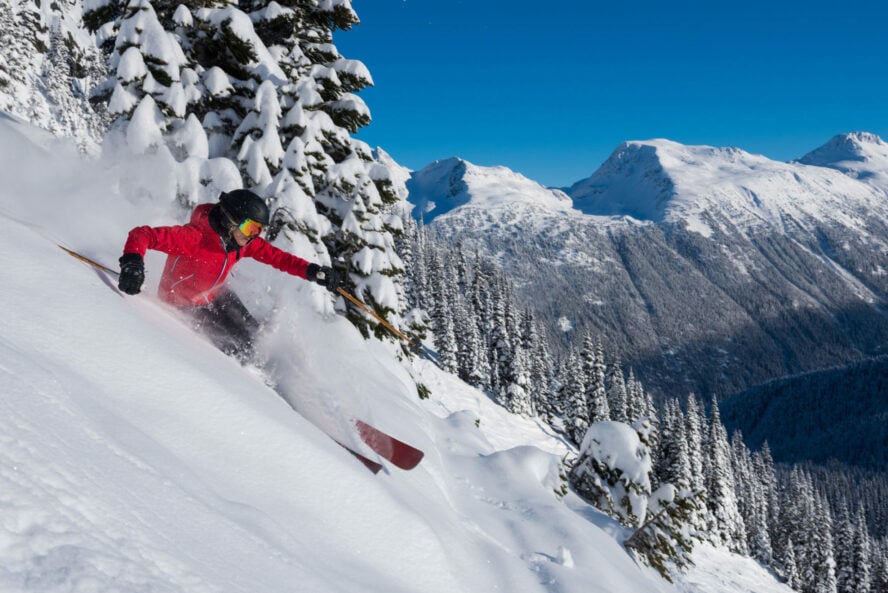
Explore expert Blackcomb terrain with the backcountry experts
Blackcomb’s backcountry access is relatively straightforward, but it gets real, really quickly! You should keep in mind that the terrain is mostly intermediate to advanced. Skilled skiers will find plenty of couloirs, glaciers and other large shredding objectives.
You should have significant backcountry experience before heading out, or do yourself a favor, and hire a local guide to show you what the mountain has to offer. The terrain is alpine, complex, and very demanding. If you’re heading to this area, Backcountry Skiing Canada has a Whistler Blackcomb backcountry ski map and some additional info to help you plan your trip.
Whistler ski tours feature backcountry huts and untracked powder
Whistler backcountry ski tours range from day trips to multi-day adventures, and the area is also known for its backcountry huts. You won’t want to miss the Kees and Claire Hut, a new backcountry hut featuring up to 38 bunks. If you’re looking for the best untracked powder in the area, there are plenty of Whistler backcountry ski guides that will get you there, such as Altus Mountain Guides and Whistler Ski Guides.
Find ample accommodations for families in Whistler
There’s lots to do in Whistler and just as many places to stay. Be prepared though, accommodations can get pricey. If the resort-side accommodations don’t seem that budget friendly, consider an Airbnb or a backcountry hut tour. If you’re travelling with family, you’ll find everything you need in Whistler Village. There are no shortage of pubs and cool spots to hang out, and check out the Family Apres for the kids.
The beauty of Whistler is the friendly competition between the two mountains — Whistler and Blackcomb. Yes, they’re side by side and practically related, but they offer very different backcountry skiing.
Whistler Blackcomb - Good to Know
Whistler: Beginner to intermediate skiers; Blackcomb: Intermediate to advanced skiers
Whistler: Tree skiing, couloirs and big alpine bowls; Blackcomb: Alpine and complex, with plenty of steep couloirs and glaciers
Base, 7155’/2181m there’s vertical gains to be had from 590’/180m (Musical Bumps) to 4,593’/1,400m (Fissile)
Base, 7,992’ (2,436m) consider vertical gains anywhere from 590’/180m (Disease Ridge) to 3800’/1150m (farther east at the NW face of Mt. Pattison via Blackcomb Glacier)
Plenty of lift options, but you really gotta work for the good stuff
Plenty of snow, though can be on the wet side due to the maritime climate
When weather isn’t ideal on Whistler, Blackcomb has more gladed runs
Ski and Snowboard Guide to Whistler Blackcomb by Brian Finestone and Kevin Hodder
Mid-January through March
Getting there
Transportation to Whistler is simple and well worth the drive. Fly into Vancouver International Airport (YVR). You can rent a car and drive the hour and a half north on the Sea to Sky Highway — one of the most beautiful coastal drives in the world. If you don’t drive, or don’t want to, shuttles to Whistler Blackcomb are direct, reliable and frequent.
4. Duffey Lake Road
Duffy Lake Road is a backcountry hot spot accessed from Whistler. “The Duffy,” as it’s known to most locals, is super rewarding, not too crowded and well worth the trip. From Whistler, drive north for about an hour and then head east towards Lillooet. You’ll gain 4000 feet on the road alone. You can find ample touring available directly from your car.Because of the proximity of the road to the terrain, you’ll get a pretty good idea of what kind of skiing awaits.
Keep in mind, inclement weather and avalanche safety are not to be underestimated here. You should be well-equipped to head onto this road. Note that conditions can get nasty, and there’s not much cell service.
What to know before you go to Duffy Lake
There’s plenty of tree skiing and great access to alpine terrain. Depending on objectives, there’s a great backcountry cabin accessible from this road called Cerise Creek Cabin. Check it out. Plus, there are plenty of options for accommodations in nearby Pemberton and Whistler.
Because of the proximity of the road and the terrain, you’ll get a pretty good idea of what kind of skiing awaits. All you have to do is park your car, pick an objective and head out.
Duffey Lake Road - Good to Know
Intermediate to advanced
Couloir, glaciers, tree skiing, bowls, high angle descents
Consider elevation gains anywhere from 2624’/800m (Rohr Ridge) to 3300’/1000m (Vantage Peak)
Drive your car. Park your car. Start your ascent.
Duffy Lake is more inland, so the snow quality is excellent
Can be difficult and dangerous in whiteout conditions. Plan accordingly
Here’s a great map offered by Backcountry Skiing Canada
Mid-January through March
Getting there
You’ll need a car to get to The Duffy, which is a 2.5-hour drive from Vancouver International Airport (YVR). Located between Pemberton and Lillooet, Duffy Lake Road offers secluded ski spots just off road.
5. Chic-Chocs
While many skiers don’t think of Quebec as a ski touring destination, in the Chic-Choc Mountains, backcountry skiing is as good as it gets in Eastern Canada. With amazing tree skiing, couloirs, and plenty of open glades, it’s an almost-western skiing experience in the east. Access is easy. You’ll find plenty of options for any skill set. Plus, you’ll be greeted by a culture and atmosphere totally unique to other Canadian destinations.
The Chic-Chocs are worth the trek
The Chic-Chocs are some of the oldest mountains in Canada. With open bowls reminiscent of Colorado, tree glades that share a strikingly similar feel to BC, and snow that can hold its own against the best European spots, Chic-Choc ski touring is a definite must for anyone adventuring on the east coast. The views are truly amazing as they run dead parallel with the St. Lawrence River. This spot is out of the way (a seven-hour drive from Quebec city). The payoff is that Chic-Choc is far less crowded than other top backcountry ski spots. Look in and around Murdochville, Quebec, for places to stay. If you want to make it a truly epic backcountry trip, consider a lodge like the Chic-Choc Mountain Lodge.
While many skiers don’t think of Quebec when they think of backcountry skiing, the Chic Choc Mountains offer the best backcountry in Eastern Canada.
Chic-Chocs - Good to Know
Beginner to advanced, depending on location
Couloirs, glades and trees. Everything, really!
4,160’. Consider 1640’/500m (Vallieres-de-Saint-Real) or 1814’/553m (Mt. Albert)
Most runs require some effort, but a couple runs are more forgiving (Mount Lyall)
January – March
Continental pack. Light and dry
Cold and can be a little damp due to proximity to the ocean and St. Lawrence
Chic Chocs Backcountry Touring Guidebook by Avalanche Quebec
Getting there
This destination is Canada’s hidden gem. The Chic Chocs are located in Gaspé Peninsula, Quebec. Murdochville is about an hour away. Getting there takes some time. It’s a seven-hour drive (more or less) from Quebec City, but skiers who make the trip always say it’s worth the journey. Another option is to take a plane from Quebec City to Mont Joli Airport and rent a car from there.
6. Golden
Located in Southeastern British Columbia’s Selkirk Mountains, Golden backcountry features access from Kicking Horse Mountain Resort. The area is mostly complex with alpine skiing. Although access is somewhat easy, the terrain and snowpack are serious and must be respected. You’ll discover some glade skiing, along with pillow lines and just about anything else you can anticipate. Golden sees slightly less snowfall than Revelstoke and Rogers Pass, but there’s less people too. All that space makes it an awesome spot to spend your time.
Accommodations in Golden
There’s anything and everything in Golden to suit a variety of tastes. You just need to find what fits your needs and budget. Many skiers make the journey here during the high season, so there’s an abundance of accommodation options from fancy hotels to secluded lodges. You can also enjoy awesome hut-based skiing available here, depending on how you’re looking to spend your downtime.
Golden - Good to Know
Suited to advanced skiers
Deep chutes, big bowls, some tree skiing
Consider elevation gains anywhere from 1,640’ from G7 Corner (Reudi’s Ridge South) to 492’ (Ozone)
Easy from Kicking Horse Mountain Resort. Get a quick gondola boost to a serious 7545’
Excellent dry, light powder
With not too many off days, it’s kinda perfect
Late January through early March
Getting there
There is the Golden Municipal Airport, but it has some aircraft restrictions. Most travelers will opt for flying into Calgary International Airport (YYC), which is about a 3-hour drive. Golden is a well known ski destination, so you’ll have many options to get from the airport to your hotel or rental.
7. Sunshine Village
Sunshine Village is famous for possessing Canada’s best snow, as well as three mountains each offering varied terrain. The Sunshine Village Ski Resort has some beginner terrain, but advanced skiers won’t want to miss Delirium Dive. The Dive is a controlled backcountry area in Alberta’s Banff National Park. You’ll discover serious skiing and steep angles. With plenty of alpine terrain in this zone, it is a great place for advanced skiers to test their mettle in the backcountry. Depending on the season, opening dates are subject to the resorts careful discretion. You gotta be sure to bring all your avy gear and a skiing partner too. It’ll be worth it.
Where to stay in Sunshine Village
Canadian lodges are most popular among guests, but you can choose from plenty of hotels and apartments, too.
With plenty of alpine terrain this zone is a great place for advanced skiers to test their mettle.
Sunshine Village - Good to Know
Intermediate to expert
Tree skiing, couloirs, steeps, cliffs, chutes
8,960’ a couple runs include 689’/210m (Rock Isle Lake Area) or 2,264’/690m (Delirium Dive)
Solid access from the resort
Continental pack. Light and dry
It’s definitely colder here. And snow keeps much longer after a storm
Check out this Lake Louise, Sunshine and Banff Ski Touring Guide from Backcountry Canada
February through April
Getting there
Calgary is your best bet, from there you can rent a car or take a bus or shuttle to Banff. Just like Lake Louise, you head west from there for about a half hour, where you’ll find tons of great advanced, off-piste skiing options.
8. Icefields Parkway
The Icefields Parkway, known as Highway 93 to most, links Lake Louise and Jasper, with Banff and Jasper National Parks at either end. You’ll find a continental snowpack here with solid skiing between January and May. This area boasts endless backcountry options whether you’re looking for tree skiing or huge alpine descents.
Plenty of eye-catching lines between Banff and Jasper
Either way, if you’re traveling between Banff and Jasper, you may find some lines to distract you mid-journey. Always be sure to be mindful of the weather and avalanche reports. Road conditions can be also tough, so check with the weather service before you go!
Accommodation and lodging
There are just a handful of lodges along the Parkway. Consider accommodations in Jasper or Lake Louise. Then, plan your day trips accordingly.
The alpine terrain is definitely worth seeking out, but because of the complexity of the terrain and snow, you’ve got to be patient and carefully pick your lines.
Icefields Parkway - Good to Know
Intermediate to advanced
Depending your destination, there’s a bit of everything
6,788’ Depends on destination
All done the old fashioned way. Drive. Park. Skin to ski
Light and dry
The season is good, but colder than other hotspots
Mid-December through April
Getting there
The Icefields are also known as Highway 93, and this parkway stretches 143 miles (230km) from Lake Louise to Jasper. Lake Louise is 40 minutes west of Banff and a little over 2-hour drive to Calgary International Airport (YYC). Highway 93.
9. Lake Louise
The backcountry access off the ski hill at Lake Louise Ski Resort is good but not extensive. You’ll find some tree skiing and plenty of alpine bowls, which is mostly what Lake Louise is known for. The alpine terrain is definitely worth seeking out. Because of the complexity of the terrain and snow, you’ve got to be patient and carefully pick your lines. The area has a continental snowpack that really depends on the season. I’ve always thought it best between February and April. You’ll also be able to select from plenty of cozy lodges and hotels outside of Banff National Park.
The alpine terrain is definitely worth seeking out, but because of the complexity of the terrain and snow, you’ve got to be patient and carefully pick your lines.
Lake Louise - Good to Know
Suited to advanced skiers, but there are options for all
Bowls for days, open slopes, tree glades
8,650’ Consider elevation gains anywhere from 3,117’ (Redoubt Bowl) to 2,461’ (Surprise Pass)
There’s lift access from the resort for skiing out
Not the most quantity, but the powder is light and dry
The season is good, but colder than other hotspots
Not a book, but an awesome Backcountry Skiing Canada map!
February through mid-April
Getting there
The closest town is Banff but most skiers travel from Calgary. Lake Louise is a well known ski destination, so you don’t have to rent a car at the airport (unless you want to, of course). You’ll find plenty of busses and shuttles, but if you do rent a car you’ll be able to explore other off-piste destinations like the Icefields.
10. Kananaskis Country
Welcome to Kananaskis Country — or K-Country — the closest backcountry skiing area to Calgary! You’ll find a wide variety of everything here from beginner to advanced, tree skiing to alpine bowls and mountain tops. And, the routes here are long. While it’s awesome to have skiing this close to Calgary, it takes a little longer to get into the solitude of the Kananaskis backcountry.
Peter Lougheed Provincial Park is located within the expansive Kananaskis area, just an hour and half west of Calgary and even closer to Canmore. It’s the perfect option for those looking to travel not that far. Keep in mind, Burstall North Pass is one of the shortest tours in the area, and consequently one of the busiest. It has a couple of options for routes.
Kananaskis accommodations
Lodges are more popular than hotels in this area, so consider one and treat yourself to a private and cozy accommodation. There’s also plenty of top notch hotels in nearby Calgary.
You’ll find a wide variety of everything here, from beginner to advanced form tree skiing to alpine bowls and mountain tops.
Kananaskis Country - Good to Know
Intermediate to advanced
Glaciers, glades and trees, everything depending on destination
A couple runs include 900m/2952’ (French Glacier) or 548m/1800’ (Black Prince)
Most runs require a good hike, bootpack or skin
Continental pack. Light and dry
Cold, but the snowpack is what to look out for, not the storms
Summits and Icefields 1 by Chic Scott and Mark Klassen
February through April
Getting there
Calgary. All the way. From there, rent a car and you can be skiing before you know it.
11. Whitewater Ski Resort
The Whitewater Ski Resort is just outside of Nelson, BC. Whitewater offers solid access to beginner and advanced terrain, all via lift access just outside of the resort. Here, you’ll find lots of tree skiing, burnt trees, and alpine features. It should be noted for those of you venturing out here that strict backcountry rules in place. Be aware and considerate when exploring the area. This particular region of the Selkirks boasts significant amounts of cold, dry snow. Even with its epic powder, the crowds aren’t bad — at all.
Whitewater Ski Resort accommodations
Accommodations in Whitewater are plentiful, although perhaps not as involved as others on this list. Regardless, there are creature comforts to be had on any budget.
The Whitewater Ski Resort just outside of Nelson, BC, offers solid access to beginner and advanced terrain, all via lift just outside of the resort.
Whitewater Ski Resort - Good to Know
Mostly suited to advanced skiers but options available for all
Tree skiing, alpine terrain, plenty of powder skiing
6,709’/2,045m consider elevation gains anywhere from 2200’/670m (First Choice) to 1300’/396m (Acidophilus)
Solid slackcountry access from the resort
Excellent dry, powder
Not too many off days here
backcountryskiingcanada.com has a great map!
Mid-January through early March
Getting there
Fly into either Vancouver or Calgary, then get a connecting flight to Cranbrook (YXC). Once you get to Cranbrook, plan on renting a car because shuttle service to Whitewater is minimal. If you don’t fly to Cranbrook, rent a car from the airport and make the journey. You need good driving skills though, it can be a challenging trek in winter conditions.

